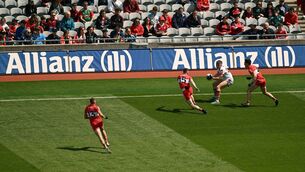Phil Hughes tragedy reminds us of the inherent dangers in sport

Ralph Waldo Emerson described it as the “bloom and glow” of perfect health. Over two millennia separated those observations, which only goes to show how ingrained is the belief that the games we play are a force for good. And yet, such rhetoric sounds hollow on the back of news that cricketer Phil Hughes has lost his life two days after being struck in the neck by a delivery while batting for South Australia.
Hughes’ tragic passing is another reminder that the sports to which he assign our deepest affections are pastimes which would — let’s be honest here — be described as sheer lunacy were they dreamed up in this modern age of health and safety and not by a bunch of Victorian upper-class Englishmen who saw sport as a means of preparing their young men for the trials and tribulations of ruling their empire and, thus, the world.
Strip away the 150 or so years sport has spent winding its way to the very heart of society and we can only imagine what the reaction would be if, say, cricket was invented now and the rules explained. ‘So, let me get this straight: you want me to stand over there and have someone throw a rock hard ball made of cork and leather at me at speeds of anything up to 100mph?’
Soccer, too. Can you imagine the furore if a newfangled craze took off whereby hitting a moving leather ball with your unprotected head was a staple part of the game? And let’s not even contemplate the rush towards apoplexy if something like rugby or boxing was to be codified and suddenly click with the global zeitgeist.
Yet, like it or not, sport is inherently dangerous.
Vince Lombardi, the iconic coach of the Green Bay Packers in the 1960s, put American football in its proper context when asserting that gridiron was not a contact sport, but rather a collision sport. “Dancing is a contact sport,” he corrected people at the time. No doubt, the four Irish rugby players taken off with suspected concussion against Australia last Saturday would agree.
Lombardi’s assertion carries even greater weight in an age when sport has attracted ever more interest from academics and scientists. The University of Manchester roped boxer Ricky Hatton, at the time an undefeated world champion, in for a study seven years ago when they discovered that ‘The Hitman’ delivered a punch with a force of 400 kilos and at a top speed of 32mph.
Ten times that of your average Joe, basically.
Research carried out by Chris Baron, strength and conditioning coach with Warrington Wolves, has found that your average tackle in rugby league registers in the region of 14 Gs. Or, to put it in layman’s terms, the equivalent to being hit by a car that is travelling at 50mph. Rugby union has uncovered similar figures.
And yet, for all that, the number of fatalities in organised sport remains what one academic journal has called “surprisingly low”. Bandolier, an evidence-based health publication put together by Oxford scientists, said as much after picking through the bones of various academic studies and government-backed reports a few years back.
What they found flummoxed, in that football was rated more dangerous than hang-gliding, tennis was more fraught with peril than horse racing and table tennis more of a threat to your life than skiing. But then, findings change depending on what you use to measure them. The Oxford dons used the rate of fatalities for their purposes. Forbes.com, who undertook a similar investigation in 2008, found basketball to be the most inherently dangerous, based solely on the volume of injuries reported in the USA.
Is sport more or less dangerous now than it used to be? Yes and no. Rules and regulations have been tightened up considerably, but advances in sports science, diet and the injection of ludicrous amounts of money have increased the speed and power of its practitioners as well as the frequency of events held.
Everywhere you look, sport has sought to adapt its codes to the avoidance of serious injury, or worse. Soccer is almost non-contact now; rugby and American football are having to tweak their games to account for the growing concerns over, among other things, concussion; headgear has been removed from amateur boxing in the belief that it only adds to the damage caused to the brain; hurling has made helmets and mouth guards compulsory and drafted in the so-called ‘Nash Rule’ for penalty-takers.
And on that list goes.
There is no magic formula. Cricketers, for instance, have been known to lose their lives — infrequently it should be added — while at play since at least 1870, when Nottinghamshire’s George Summers died four days after being struck on the temple while at the crease.
Summers wore no helmet. Hughes did.
Ultimately, there is no failsafe solution, just a trickle of changes that you would hope and pray can ensure that incidents like that in Australia this week are even less common going forward than they are today.
Email: brendan.obrien@examiner.ie
Twitter: @Rackob











